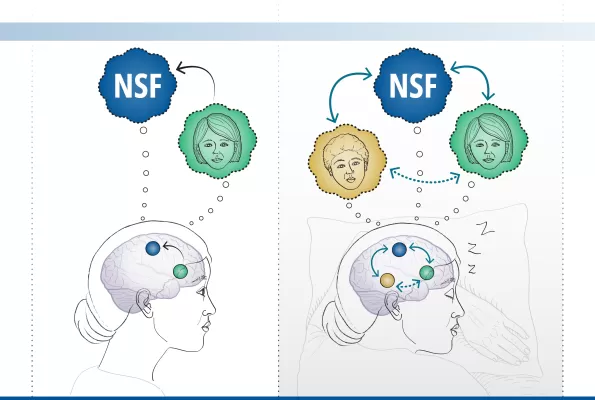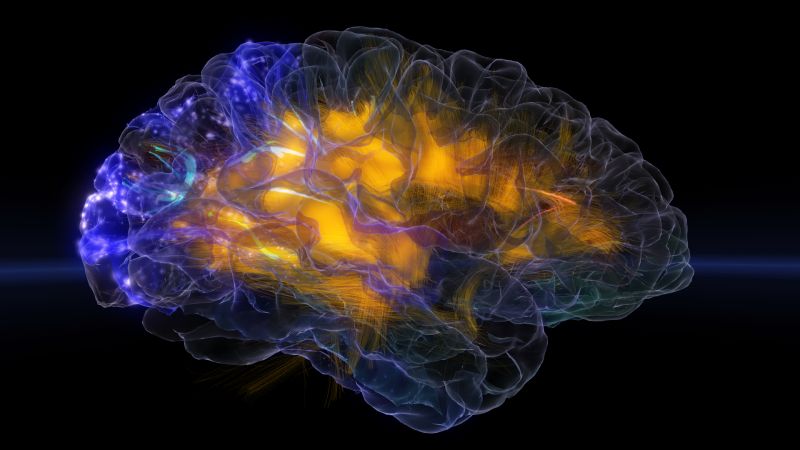
Nightlife of the brain
While we rest peacefully at night, our brains remain hard at work. They are processing the events we experienced that day and consolidating them in memory, while simultaneously keeping track of what is going on around us, cleansing toxins, and preparing us for the next day.
So much of the brain's innerworkings are still a mystery — and even more so when we are asleep. How much does the brain process from the outside world while we are sleeping comfortably, though? It turns out, brains never completely tune out the environment and are always making connections. Several U.S. National Science Foundation-powered studies have found different ways the brain is processing information while we sleep. In addition, these research paths may lead to ways to enhance learning and treatments for some characteristics of neurological disorders.
Hearing while we sleep
A study by scientists at Tel Aviv University and UCLA used sounds to explore how sleep blocks sensory signals from waking us by reaching our conscious awareness. The researchers found that when they played sounds, the individual neurons in the area of the brain responsible for early auditory processing responded when the subjects were asleep. However, the usual neural feedback signaling associated with conscious recognition was absent.
"We were looking at how the neurons respond to external sound during sleep. What's a little astounding is that it is like when you look at a Mozart piece, there's a fidelity in the performance. I think it's like every player (the neuron) is playing with great fidelity, but the conductor of the orchestra (the consciousness) is not present. There is an aspect that is missing that is probably found during conscious processing of information," explained UCLA researcher Dr. Izhak Fried, one of the lead investigators of the project.
Their results imply that the brain is still processing sensory information when you sleep; but your consciousness is not made aware of it. The lack of feedback signals from the consciousness lost during sleep is the reason that quiet or constant noises do not wake people.
Relational memory
While you are constantly processing everything you feel, see, hear, smell and taste both day and night, sleep is when the memories you made during the day are consolidated and become more permanent. However, your brain is doing more than just recording what you experienced during the day; it is also making new connections of related events.
Relational memories arise when associations are made connecting related events or attributes (i.e., names with faces). Maxim Bazhenov, a professor of medicine, and Timothy Tadros, a recent doctoral graduate from Bazhenov's lab at University of California San Diego, published an article describing their theoretical modeling describing mechanisms that can create and strengthen relational memories during sleep. "Every time one sees the same object, roughly the same neurons in the visual cortex would be active. If a person sees two objects in the same context, then these associations might be learned in the associative cortex by strengthening connections between neurons that represent the two objects," Tadros explained in a press release.
"In some of the behavioral work we were modelling our paper off of, that had people do this associative memory test, they found that the amount of improvement after sleep was correlated with the amount of time they spend in slow-wave sleep," Tadros explained. Based on these results, the model was designed to mimic slow-wave sleep (the deepest non-rapid eye movement sleep and an important part of memory consolidation).
The authors modeled interactions between two parts of the brain, the thalamus (a structure, nicknamed "the gateway to the consciousness," that processes sight, hearing, taste and touch signals before you are consciously aware of them) and the cerebral cortex (where attention, perception and cognition occur) to test how associative memory formation occurs during sleep. Previous researchers have found a process called sleep replay, where neurons that are involved in previously learned tasks activate during sleep. This new model explored how associative memory arise in memory formation during sleep replay.
Using this model, the brain was shown A+B and B+C, where A and C are faces and B is a name associated with both faces. A, B and C were then consolidated into memory during sleep. However, the brain takes it a step further by activating all the neurons relating to A, which causes neurons related to B to be activated and, therefore, C neurons as well. Even though A+C was never directly associated, the brain has now linked them. Understanding this process may help to improve relational memory, particularly in people with schizophrenia and autism spectrum disorder, since these and other disorders are known to cause problems with associative memory.
Motor skill improvement
"Practice makes perfect" is a saying that athletes, musicians or anyone trying to perfect a certain movement have heard many times. However, practice may not be the only important piece of improving motor skills.
A study from Northwestern University investigated if execution-based movements could be improved during sleep. Researchers started by having participants associate specific sounds with electrical activity from specific arm movements by practicing these movements first with visual and auditory cues and then only with the auditory cues. The participants were then asked to nap, and sounds — including half the auditory cues — were played once they fell asleep.
By playing the sounds associated with the movements, the researchers were using targeted memory reactivation, or TMR, to activate the memories of the movement while the participants slept. The researchers found that there was a marked improvement in how quickly and directly the participants responded to TMR from the cues they heard while they slept. While the cues ensured the reactivation of some of the motor circuits, the brain will naturally activate these circuits without the cues. It just will not be at the same frequency as with the cues.
"If you wait 12 hours after you learn something, chances are you aren't going to know that information as well. It's true for motor skills; it's true for facts … So, if you rehearse that information, it will kind of offset the forgetting," explained Ken Paller, the lead investigator. "We think that under normal circumstances both would be happening. There would be some forgetting but potentially some improvement because of this covert rehearsal."
This finding indicates that your brain plays through motor skills during sleep, which acts as additional repetition of the mental components of movements. This information could be used to help not only people trying to get a set of movements down, but also rehabilitation therapy patients with motor dysfunction due to neurological insult or injury.
Clearly, the brain is an amazing organ. While we sleep to restore our energy and have a clearer mind, the brain is still active and constantly analyzing what our senses tell it of our surroundings, making and replaying connections between things we have seen and experienced throughout the day. This not only allows us to remember what happened yesterday, but also prepare us for tomorrow.
Do you want to learn more about the brain and memory? Listen to NSF's Discovery Files feature on consolidated sleep.




